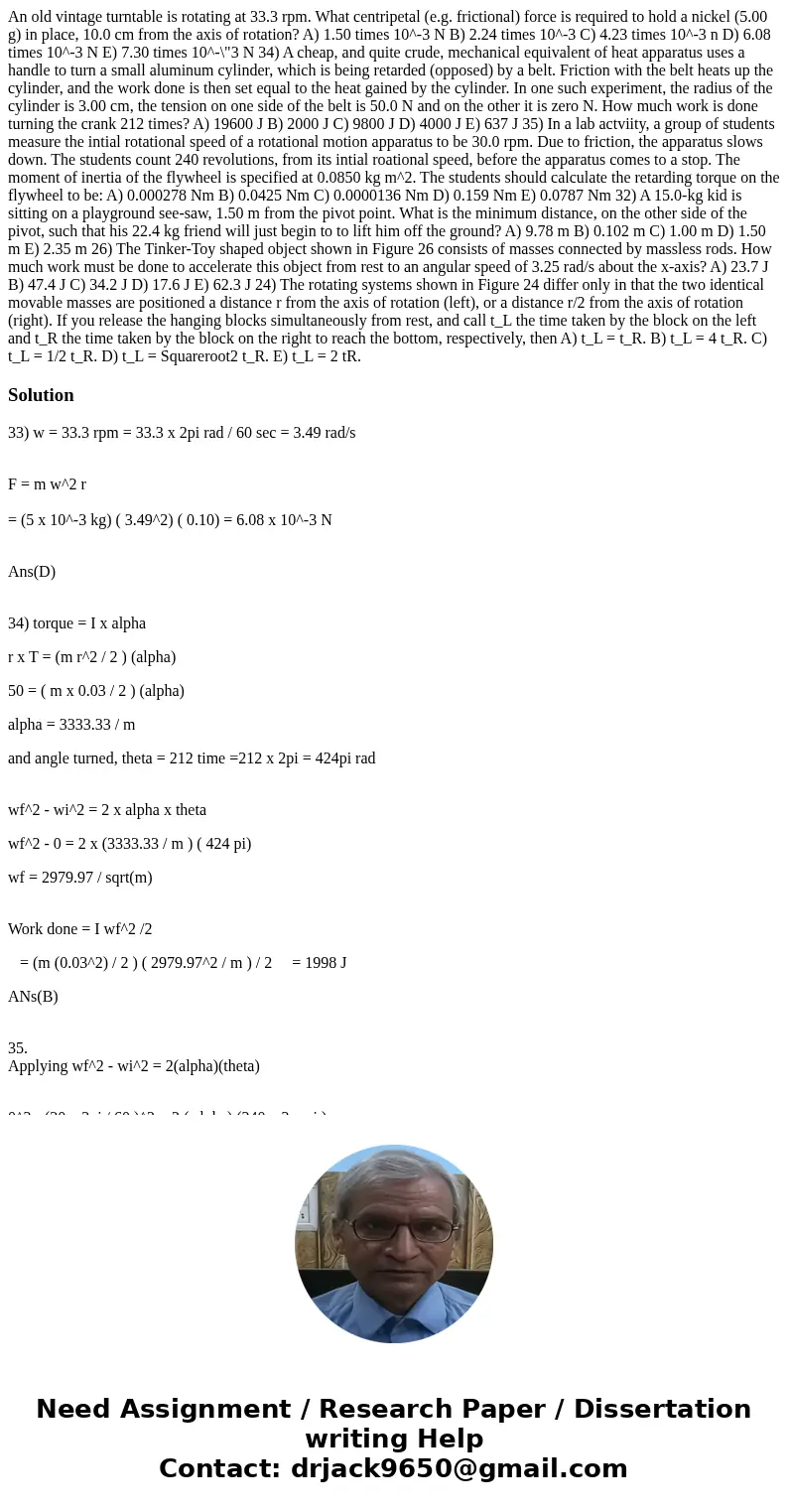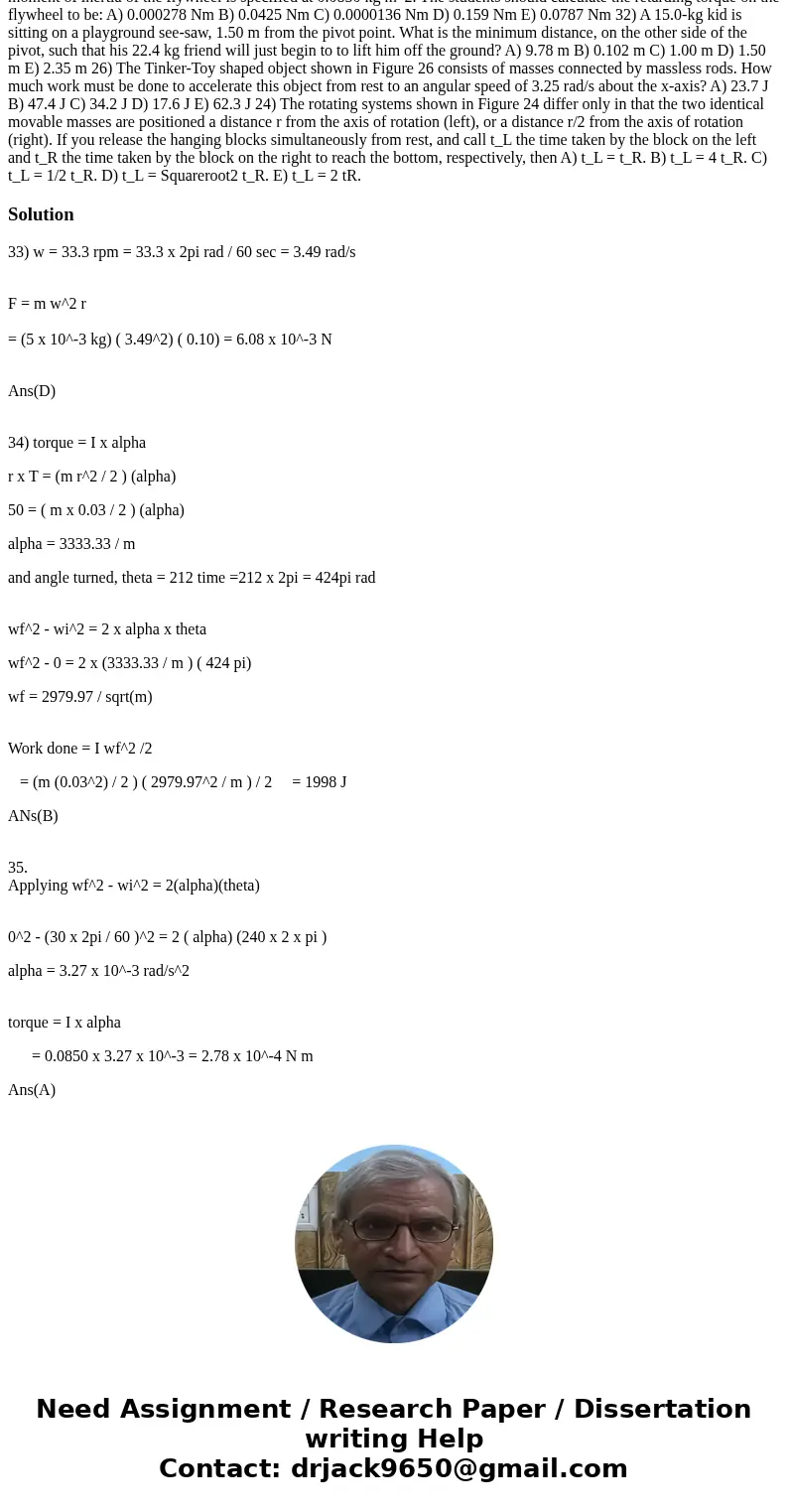An old vintage turntable is rotating at 333 rpm What centrip
An old vintage turntable is rotating at 33.3 rpm. What centripetal (e.g. frictional) force is required to hold a nickel (5.00 g) in place, 10.0 cm from the axis of rotation? A) 1.50 times 10^-3 N B) 2.24 times 10^-3 C) 4.23 times 10^-3 n D) 6.08 times 10^-3 N E) 7.30 times 10^-\"3 N 34) A cheap, and quite crude, mechanical equivalent of heat apparatus uses a handle to turn a small aluminum cylinder, which is being retarded (opposed) by a belt. Friction with the belt heats up the cylinder, and the work done is then set equal to the heat gained by the cylinder. In one such experiment, the radius of the cylinder is 3.00 cm, the tension on one side of the belt is 50.0 N and on the other it is zero N. How much work is done turning the crank 212 times? A) 19600 J B) 2000 J C) 9800 J D) 4000 J E) 637 J 35) In a lab actviity, a group of students measure the intial rotational speed of a rotational motion apparatus to be 30.0 rpm. Due to friction, the apparatus slows down. The students count 240 revolutions, from its intial roational speed, before the apparatus comes to a stop. The moment of inertia of the flywheel is specified at 0.0850 kg m^2. The students should calculate the retarding torque on the flywheel to be: A) 0.000278 Nm B) 0.0425 Nm C) 0.0000136 Nm D) 0.159 Nm E) 0.0787 Nm 32) A 15.0-kg kid is sitting on a playground see-saw, 1.50 m from the pivot point. What is the minimum distance, on the other side of the pivot, such that his 22.4 kg friend will just begin to to lift him off the ground? A) 9.78 m B) 0.102 m C) 1.00 m D) 1.50 m E) 2.35 m 26) The Tinker-Toy shaped object shown in Figure 26 consists of masses connected by massless rods. How much work must be done to accelerate this object from rest to an angular speed of 3.25 rad/s about the x-axis? A) 23.7 J B) 47.4 J C) 34.2 J D) 17.6 J E) 62.3 J 24) The rotating systems shown in Figure 24 differ only in that the two identical movable masses are positioned a distance r from the axis of rotation (left), or a distance r/2 from the axis of rotation (right). If you release the hanging blocks simultaneously from rest, and call t_L the time taken by the block on the left and t_R the time taken by the block on the right to reach the bottom, respectively, then A) t_L = t_R. B) t_L = 4 t_R. C) t_L = 1/2 t_R. D) t_L = Squareroot2 t_R. E) t_L = 2 tR.

Solution
33) w = 33.3 rpm = 33.3 x 2pi rad / 60 sec = 3.49 rad/s
F = m w^2 r
= (5 x 10^-3 kg) ( 3.49^2) ( 0.10) = 6.08 x 10^-3 N
Ans(D)
34) torque = I x alpha
r x T = (m r^2 / 2 ) (alpha)
50 = ( m x 0.03 / 2 ) (alpha)
alpha = 3333.33 / m
and angle turned, theta = 212 time =212 x 2pi = 424pi rad
wf^2 - wi^2 = 2 x alpha x theta
wf^2 - 0 = 2 x (3333.33 / m ) ( 424 pi)
wf = 2979.97 / sqrt(m)
Work done = I wf^2 /2
= (m (0.03^2) / 2 ) ( 2979.97^2 / m ) / 2 = 1998 J
ANs(B)
35.
Applying wf^2 - wi^2 = 2(alpha)(theta)
0^2 - (30 x 2pi / 60 )^2 = 2 ( alpha) (240 x 2 x pi )
alpha = 3.27 x 10^-3 rad/s^2
torque = I x alpha
= 0.0850 x 3.27 x 10^-3 = 2.78 x 10^-4 N m
Ans(A)


 Homework Sourse
Homework Sourse